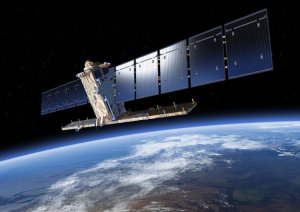A new view of our dynamic planet – why today’s Sentinel-1 launch is so important
By Tim Wright
At 21.02 (GMT) this evening, a new Era in our ability to monitor our planet’s earthquake faults and volcanoes begins with the launch of the Sentinel-1A radar satellite (Sentinel-1) from French Guyana.
Sentinel-1 – it even has a theme tune penned by Mike Oldfield (MikeOldfieldgreetingESA).
Sentinel-1 will be looking at the earth with radar vision – it shines long-wavelength radar light down from the satellite and measures the energy that scatters back to the satellite. Radar satellites work in all weather, seeing right through clouds, and can operate day and night. We’ve had radar satellites before, but this one is different. It is the first truly operational radar system – designed to provide large volumes of data routinely and reliably. When 1A is joined by 1B next year, the satellites will look at most points of the land surface every 3 days (Why_we_need_radar_satellites)
So, why is Sentinel-1 useful for earthquakes and volcanoes? The answer relies on a clever processing trick called radar interferometry or InSAR. InSAR works by comparing radar images of the ground surface with previous radar images. If the ground moves, even by as little as a millimetre, we can detect subtle changes in the signal and use these to measure the ground motion.
I lead the UK Natural Environment Research Council (NERC) Centre for the Observation and Modelling of Earthquakes, Volcanoes and Tectonics (COMET). COMET scientists have been funded by NERC (current_research) to build a processing system for Sentinel-1 to map these small ground movements for all of our planet’s hazardous tectonic belts. We will use these data to map how the ground strains around earthquake faults, how volcanoes swell and how hazards are distributed in space and time.
Building a system to handle the data from Sentinel-1 will not be straightforward – the data volumes will be enormous (enough to fill up a typical laptop hard drive four times a day), and extracting the signals will require powerful computers to be operating continuously.
Nevertheless, the scientific and societal rewards will be huge. With 3-5 years of data, we will have the first high-resolution map of tectonic strain for the planet, which is a powerful predictor for the rate of earthquake activity. We’ll also be able to respond rapidly to every damaging earthquake , using the data to make rapid assessments of the severity and location of damage, and to forecast areas where future triggered earthquakes may occur (Earthquake_conversations).
Deformation observations are also a powerful diagnostic tool for forecasting volcanic activity (volcano-deformation). Furthermore, the data will be useful for tracking the motion of glaciers, and for monitoring subsidence caused by water pumping or mining.
Of course, we won’t relax until the satellite is safely in orbit and the solar panels and radar antenna are unfurled – a process that takes more than 10 hours in all (Sentinel-1_unfolds). Sending any instrument into space is a gamble –Sentinel-1A is currently sitting on top of one of the more reliable launch vehicles (a Soyuz rocket), but things can still go wrong when you are essentially putting €280 million on a giant firework.
A group of us from COMET and the School of Earth and Environment will be nervously watching the video feed of the launch from ESA’s Mission Operation Centre in Darmstadt (sadly we didn’t get an invite to the real launch in French Guyana). You can follow what happens on twitter at @timwright_leeds, @geoandyhooper, and @sarscience, or watch the video live at (Watch_Sentinel-1_launch).
And I’ll post an update tomorrow… keep fingers, toes and anything else you can think of crossed.
Tim Wright
COMET. School of Earth and Environment, University of Leeds.

